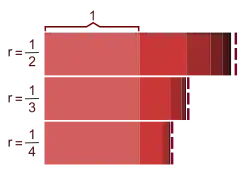Geometric series are series of the form . They are important within several proofs in real analysis. In particular, they are crucial for proving convergence or divergence of other series. We will derive some criteria using them, e.g. the ratio or the root criterion.
Geometric sum formula
We recall the geometric sum formula for partial sums of the geometric series. The proof of the sum formula reads as follows:
Theorem (Geometrische Summenformel)
For all real and for all there is:
Proof (Geometrische Summenformel)
We have
Geometric series

We consider two cases: and .
Case
We consider the geometric series for any , which especially means . The sum formula above applies to the partial sums in that case:
So the geometric series converges if and only if the sequence of partial sums converges. This is the case if and only if converges. We know that converges to if and only if and it converges to , if and only if . In this section, we only care about the first case of convergence:
If , then the geometric series converges.
Now, let us determine its limit:
Exercise (alternative proof that the geometric series converges)
Prove that the geometric series with converges to .
How to get to the proof? (alternative proof that the geometric series converges)
We need to show that for each there is an , such that
The geometric sum formula yields
Since the geometric sequence with converges to 0, so does . Hence, for every there is an with
Since is constant, there is an with
This implies the desired convergence.
Proof (alternative proof that the geometric series converges)
Let be given. The geometric sequence with converges to 0. Since , for a given there is an with
With the geometric sum formula, this implies for all that
The limit of the series is hence: .
Case
For , we have for all , that . Therefore, the sequence cannot converge to 0. So teh series must diverge (this argument is called term test and will be considered in detail, later)
The divergence becomes particularly obvious, if is positive, e.g. for . In this case, for all , we have and may estimate the partial sums: So the sequence of partial sums is bounded from below by the sequence , which in turn diverges to . So the series must diverge, as well.
Conclusion
We have learned: for , and , the geometric series diverges. These three cases can be concluded into one case . However, if , then the geometric series converges to :
Theorem (geometric series)
The geometric series converges if and only if . In that case, the limit is , or written in shorthand notation:
Example (geometric series)
For , and there is
Example problems
Problem 1
Exercise (problems: geometric series)
Compute the values (=limits) of the following series:
Solution (problems: geometric series)
Solution sub-exercise 1:
Solution sub-exercise 2:
Solution sub-exercise 3:
Solution sub-exercise 4:

Careful! The series starts with and not . So we need to shuffle terms around first before we can apply the sum formula with :
Solution sub-exercise 5:
This series starts with . We perform an index shift to get it starting with :
Problem 2
Exercise (geometric series with special )
Let with and . Find the limits of the following six geometric series:
- and
- and
- and
Solution (geometric series with special )
Solution sub-exercise 1:
and
Solution sub-exercise 2:
and
Solution sub-exercise 3:
and
Problem 3
Exercise (index shifting)
Let with . Find the limits of the three geometric series
- for
Solution (index shifting)
Solution sub-exercise 1:
Solution sub-exercise 2:
Solution sub-exercise 3:
For and there is
Problem 4
Exercise (Sequences which relate to the geometric series)
Solve the following three problems:
- For all real and , prove the limit .
- For all with , prove the limit .
- Find the limits of the series and .
Solution (Sequences which relate to the geometric series)
Solution sub-exercise 1:
For all and we have to establish
the left-hand side is re-arranged as follows:
Solution sub-exercise 2:
In the chapter Beispiele von Grenzwerten , we proved that holds for (reason: grows exponentially and "beats" the linearly growing ). The limit theorems hence yield and . Therefore
Solution sub-exercise 3:
We re-use the solution to sub-exercise 2 with :
The second limit also follows from , using an index shift:
Solution (Alternative proof to sub-exercise 1)
We may also reconstruct the limit in a similar manner to the geometric sum formula: There is a factor of in the denominator, so applying the trick "multiply by and subtract" twice, we should get to the result. We start from
And multiply the equation by :
Next, both results are subtracted:
On the left side, we may factor out a second :
Solution (Alternative proof to sub-exercise 3)
We may also add and subtract a 1:
Hint
Analogously to sub-exercise 3, one may show for every that:
just replace by